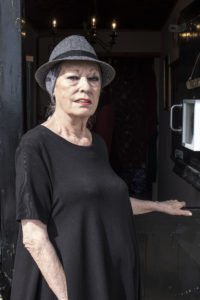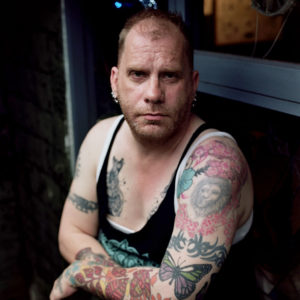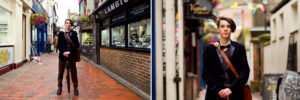Brighton Photo Biennial 2016 will look at the way photography fosters our understanding of style, the body, gender and subcultures. It is arguably the biggest visual art event on the city’s calendar, and this year the month-long festival issued a call out to BA students on Brighton Uni’s acclaimed photography course.
Four chosen artists, who appear to come from all walks of life, will feature in one of the busiest exhibition spaces in town. So if you’re passing Jubilee Square, do take some time to take in Our City, How Do We look? I spoke with the talented group at local music festival Together the People.

Interview: Chynna Guyate
It is at once a comfort and occasional source of alarm that Brighton’s sartorial flair extends to residents of all ages. So in putting together her show, Guyate has looked for “the elderly who defy age and disability and dress how they want to express themselvesâ€.
Brighton may be thought of as a city for young people to see and be seen in, but Guyate is drawn to those who have seen it all before . “These people need a voice,†she says of her subjects, “Because they’re just as great. That’s why I picked up on the older generationâ€
While aware that it might sound like a cliché, the second year student was inspired by her own 91-year-old grandma, who was living with dementia. “Despite that she loved dressing up, styling; she had all these crazy clothes. I just thought, Good on you!â€
Her show came together over three sun-drenched weeks this summer and Guyate recalls “going around and seeing who’s about, clicking awayâ€. She staked out her subjects from cafes and soon learned how to get up the nerve to approach strangers in the street.
“These people were fairly rare,†she points out. “So when you see them it was, Right, just got to go and do it.†The result is a portfolio of straightforward portraits and glimpses such as you or I might catch of these older denizens one hesitates to call eccentric.
All the same, Guyate does report an encounter with a man festooned with keyrings, who was pushing his own wheelchair, and a woman on the beach playing a tambourine to the seagulls. “That was pretty interesting,†she tells me with wry understatement.
Old people clearly have to work hard to achieve visibility. But Guyate finds in their “crazy colourful clothesâ€, an intriguing reflection of our “crazy colourful cityâ€. Expect a crazy and colourful display during BPB16.

Interview: Jennifer Jackson
After several moments talking with Jackson, it seems there’s more to gender than male, female, and trans-one-way-or-another. The third year photographer introduces me to the term non binary to describe a group of people who subscribe to neither gender norm.
“I use ‘them’ and ‘they’ pronouns rather than he or she,†they advise me and their portrait-based show is about making visible a diverse non binary community which was a lot larger than Jackson at first expected it to be, even in a city with a vibrant LGTB scene like Brighton.
Not that one can make assumptions about the sexuality of people who might simply be gender queer: “There’s a lot of people who identify very differently within it and express their non binary very differently,†says Jackson.
Although on the boyish side of feminine, this photographer looks fairly conventional. “A lot of people who are more openly non binary might present in a more radical way,†they say. So, the show is not short of telling details in clothing, modifications, tattoos, and hairstyle.
“But there are a lot of people who are non binary who are exactly like everyone else on the street,†Jackson tells me. “Maybe very feminine, or very masculine. Other people are androgynous. So I think it’s impossible to tell. It’s just a feeling really.â€
Whatever the case, it is a feeling which is safer to express here in Brighton, as compared with the far flung northerly region where the photographer originates. “In Cumbria there are still difficulties in being accepted,†they tell me. “I can’t imagine anywhere being as accepting as Brighton is.â€

Interview: Sophia Wöhleke
Although Brighton has its share of fashion chainstores, it does more than most cities to redress the ecological and ethical balance. Look no further than the North Laine and London Road, where second hand shops encapsulate something of the spirit of this city.
Now in her third year, Wöhleke came from Marseille to join the BA in Photography and having done so she brings an outsider’s eye to what seems to be a growing proliferation of thrift stores, upcycling workshops, leather workers and cobblers.
With an avowed interest in “sustainable fashionâ€, Wöhleke makes clear: “We live in a consumerist society where little emphasis is placed on the durability of items. Brighton is a city where there is a trend of people going against thatâ€.
So the well-travelled photographer turned her lens on the retailers hitting back and stalked the city’s most bohemian streets to find alternatives to Top Shop etc: “I wanted to look at it from a grassroots perspective while focusing mostly on little shops in order to gain an understanding of how people make a living without succumbing to the consumerist culture that exists elsewhere in Brightonâ€.
Most businesses were open to participation in a student project. “The first place I photographed was an alterations place. The owner only opened the shop last year and she sometimes has to work nights to finish her orders on time,” says Wöhleke. “She was open about how she works and didn’t mind me photographing anywhere, she helped me out quite a lot.â€
Her industrious subjects were also open about their working environments; “I wanted to bring the different layers of the shop into the pictures because I wanted to get a sense of the amount of manual work and time that go into running small businesses like theseâ€.
Wöhleke uses a medium format camera to capture all that rich detail. Her only remaining challenge: finding room for a tripod.

Interview: Judith Ricketts
A show that combines fashion with the realities of Brexit may sound unlikely; the Leave campaign was marred by many things, not least the double-breasted blazers of its chief protagonist Nigel Farage. But third year Judith Ricketts is interested in both all the same.
Ricketts has responded to the referendum by finding EU nationals living in Brighton and taking their portraits in the city they have thus far called home. Subjects were invited to choose a location that had personal meaning and dress to represent themselves to the world.
The concerned photographer reports a general reaction of shock to the outcome. “People were saying they felt very much under the microscope,†she tells me. “Because the vote was most focussed on immigration and before that they were part of the landscapeâ€.
Ricketts’ interests in home and displacement may stem from her African-Caribbean parentage: “I was wondering how that moment in time changes peoples sense of belonging in a city, because one of the things about this city is, I think, it’s always very, very multi-cultural.â€
The resulting show brings documentary up flush against a conventonal fashion shoot. But the photographer in question sees fashion as political. “It’s a complete identity statement,†she tells me, before adding: “Our identities are fluid. They change depending on who we are, who we are with, and where we liveâ€.
In the case of this show, subjects were persuaded to meet in town at seven or eight in the morning and talk about their experiences of the disaster known as Brexit. (“You have to make that connection really quickly!†Ricketts tells me.)
“Most people I photograph become my friends,†she adds. “They become part of my own identity, because I use it as an opportunity to get to know different kinds of culture.†This attitude, which realises we are in fact lucky to mix with different nationalities, is refreshing, even in Brighton.
Our City, How Do We Look? is a Photoworks/Together the People co-comission for Brighton Photo Biennial 2016. Work by all four photographers can be seen in Jubilee Square, Brighton, between 1-30 October 2016.